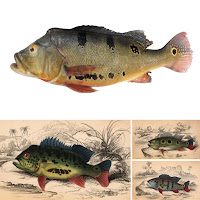 |
| [upper] Cichla cataractae
Sabaj, López-Fernández, Willis, Hemraj, Taphorn & Winemiller, 2020
facebook.com/DonaldTaphorn
[lower] Cichla ocellaris Bloch and Schneider 1801; C. orinocensis Humboldt 1821 & C. temensis Humboldt 1821
|
Abstract
A new species of peacock bass, Cichla cataractae, is distinguished from all congeners by molecular evidence and unique patterns of adult and juvenile pigmentation. Juveniles (<150 mm SL) have sides of body dominated by a series of three conspicuous dark blotches with the one below soft dorsal fin largest, attenuated posteriorly (long teardrop shape) but distinctly separated from elliptical caudal blotch; same blotches eventually with pale border (ocellated) in largest juveniles. Adult pattern on sides dominated by two distinct dark blotches, each one ocellated; anterior blotch rounded, located below anterior base of spinous dorsal fin and not extending above anterior lateral line; posterior blotch highly irregular in shape, located below soft dorsal fin and often displaced dorsally; additional dark blotch below posterior base of spinous dorsal fin generally absent or small, ocellated or not, and level with anterior blotch; vertical bars on sides generally absent or faint; postorbital stripe always present, highly broken into irregular series of dark spots, each one usually ocellated. Cichla cataractae is endemic to the Essequibo Basin where it typically inhabits rocky shoals in river channels with swift current. The new species is sympatric with the more widely distributed C. ocellaris, a species that prefers lentic habitats. Molecular analysis supports C. cataractae as a distinct lineage in a clade of Cichla containing C. temensis, C. melaniae, C. mirianae, C. piquiti and C. pinima. The oldest extant specimens of the new species were collected by Carl H. Eigenmann in 1908 and documented in his seminal "The Freshwater Fishes of British Guiana" (Eigenmann, 1912).
KEYWORDS: biodiversity, biogeography, freshwater, neotropical, systematics, taxonomy
Cichla cataractae, new species
Falls Lukunani
Distribution and habitat.—Cichla cataractae is only known from the Essequibo River channel and its major left-bank (western) tributaries draining the Guiana Shield uplands such as the Cuyuní, Mazaruni, Burro Burro and Rupununi (Fig. 7). The species is strongly associated with rocky shoals in flowing channels of clear to mildly turbid rivers. This affinity for water flowing over rocks is the reason for its local name, Falls Lukunani. Adults and subadults are not normally found in floodplain habitats, but the species likely enters flooded marginal areas during some periods and life stages (e.g., as broodguarding adults or juveniles seeking food and refuge from predation).
Etymology.— Species name derived from cataractae, Latin for waterfall or rapids; treated as a noun in apposition.
Local names.— In Guyana, Cichla cataractae is often distinguished as the Falls Lukunani whereas C. ocellaris is considered the Pond Lukunani.
 |
| Fig. 7. Distribution of Cichla cataractae, n. sp., in the Essequibo Basin. Star denotes type locality. Base map by J. Armbruster. |
Mark H. Sabaj, Hernán López-Fernández, Stuart C. Willis, Devya D. Hemraj, Donald C. Taphorn, and Kirk O. Winemiller. 2020. Cichla cataractae (Cichliformes: Cichlidae), New Species of Peacock Bass from the Essequibo Basin, Guyana and Venezuela. Proceedings of the Academy of Natural Sciences of Philadelphia. 167(1); 69-86. DOI: 10.1635/053.167.0106






